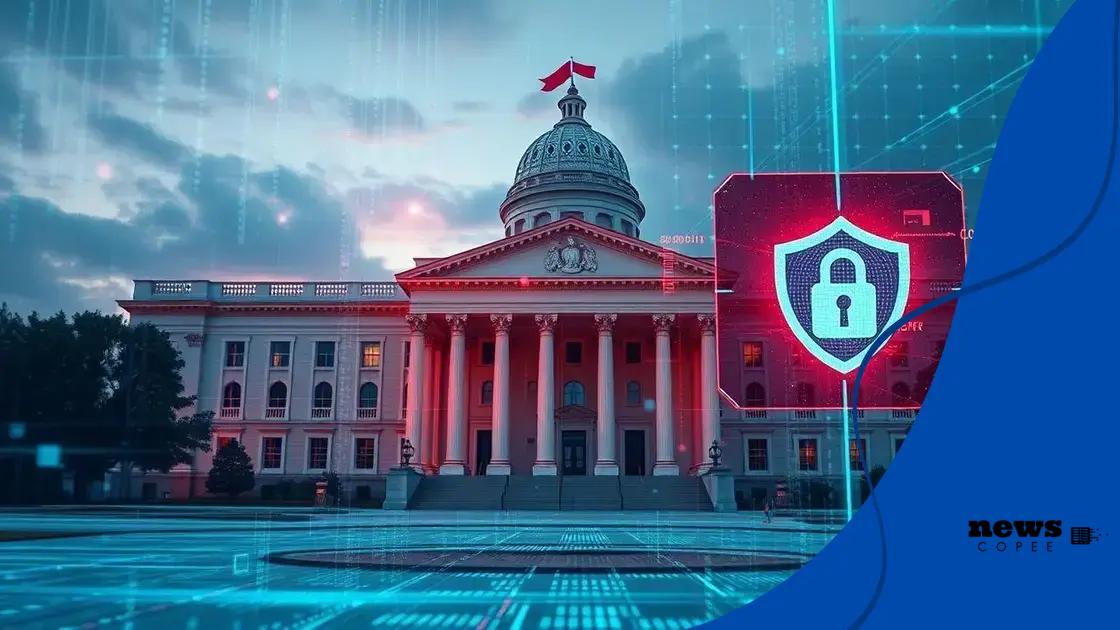Cybersecurity threats addressed by government policies

Cybersecurity threats addressed by government include stricter regulations, enhanced data protection laws, and increased public awareness to combat risks and ensure online safety for individuals and organizations.
Cybersecurity threats addressed by government efforts are more prevalent than ever. With rapid advancements in technology, knowing how these threats impact us is vital. Let’s delve into what governments are doing to counter these risks.
Understanding cybersecurity threats
Understanding cybersecurity threats is essential for individuals and organizations in our digital age. As technology evolves, so do the methods used by cybercriminals. Knowing what these threats are can help us defend against them.
Types of Cybersecurity Threats
Cybersecurity threats come in various forms, with some common ones posing significant risks:
- Malware: Software designed to harm or exploit any programmable device, service, or network.
- Phishing: Attempts to deceive individuals into revealing sensitive information by masquerading as a trustworthy entity.
- Ransomware: A type of malware that encrypts the victim’s files, demanding payment for their release.
- DDoS Attacks: Overloading a network with traffic to disrupt service.
Each of these threats requires different strategies for prevention and response. Developing an understanding of each one can empower users to take action. For instance, recognizing phishing attempts early can prevent data breaches.
The Importance of Awareness
Awareness plays a crucial role in combating cybersecurity threats. By staying informed about current trends and tactics, individuals and businesses can better prepare themselves. This proactive approach involves regular training and updates on potential risks.
Moreover, sharing information about new threats among peers can create a network of vigilance. Collaboration and communication enhance our collective defense strategies against cyber risks. With the right tools, anyone can stay safe in the digital world.
Government initiatives tackling cybercrime
Government initiatives tackling cybercrime are essential to protect citizens and businesses. As technology grows, so do the responsibilities of governments to ensure safety online. Various actions are being taken to address these threats effectively.
Legislation and Regulations
One of the key strategies involves creating laws to punish cybercriminals. These regulations help set the framework for legal consequences. Some important laws include:
- Computer Fraud and Abuse Act: Targets hacking and unauthorized access.
- General Data Protection Regulation (GDPR): Ensures personal data is protected.
- Cybersecurity Information Sharing Act: Promotes sharing of threat data among organizations.
By establishing strong laws, governments can deter potential cybercriminals and hold them accountable for their actions.
Collaborative Efforts
Collaboration between government agencies and private companies is another vital component. These partnerships allow for sharing resources and best practices. Working together can lead to improved responses to incidents and better security measures.
Additionally, training programs are offered to educate employees about cybersecurity threats and best practices. By raising awareness, organizations can better prepare for attacks.
In many instances, governments also lead cybersecurity exercises to test response capabilities. These exercises help identify weaknesses and improve overall readiness against cyber threats.
Impact of regulations on businesses

The impact of regulations on businesses is significant, especially regarding cybersecurity. Regulations enforce standards that help protect companies from cyber threats while ensuring consumer trust. These rules create a framework that organizations must follow, influencing how they operate.
Compliance Requirements
Businesses must comply with various cybersecurity regulations. Some key compliance areas include:
- Data Protection: Companies must implement measures to safeguard personal information.
- Incident Reporting: Firms are often required to report data breaches within a specific timeframe.
- Regular Audits: Organizations may face periodic security audits to ensure compliance with established policies.
Meeting these requirements can be challenging but helps reduce risks. Failing to comply can result in hefty fines and damage to reputation.
Cost of Compliance
While regulations aim to enhance security, they also increase operational costs. Implementing necessary systems and processes can require a significant investment. Smaller companies might face greater challenges due to limited resources.
However, the cost of non-compliance can be even higher. Data breaches can lead to lawsuits, loss of customer trust, and operational disruptions. Therefore, investing in compliance is an essential aspect of running a successful business.
By adhering to cybersecurity regulations, organizations not only protect themselves but also contribute to a safer online ecosystem.
Best practices for individuals
Understanding best practices for individuals regarding cybersecurity is crucial in today’s digital world. Each person plays a role in protecting themselves and others from cyber threats. Simple actions can lead to safer online experiences.
Strong Passwords
One of the first defenses against cybercrime is using strong passwords. A robust password should:
- Be at least 12 characters long.
- Include a mix of letters, numbers, and special characters.
- Avoid common words or phrases.
Changing passwords regularly and using unique passwords for different accounts will further enhance security.
Awareness of Phishing Scams
Individuals must stay alert for phishing scams. These attacks often seek to trick users into providing personal information. Recognizing these scams is key. Signs of phishing include:
- Emails that create a sense of urgency.
- Suspicious links or attachments.
- Unfamiliar sender addresses.
It’s important to verify the legitimacy of requests before clicking any links or sharing details.
Regular Software Updates
Keeping software up to date is another essential practice. Regular updates help patch security vulnerabilities. Whether it’s your operating system or applications, updates often include important security fixes.
Furthermore, enabling automatic updates can help ensure that apps and systems remain secure without requiring constant manual checks.
Lastly, utilizing security tools like antivirus software can add an extra layer of protection. These tools help detect and eliminate potential threats before they cause harm. By adopting these best practices, individuals contribute to a safer online environment.
Future trends in cybersecurity legislation
The future trends in cybersecurity legislation reflect the evolving challenges businesses face in today’s digital landscape. As technology advances, so does the need for updated laws to protect sensitive data and ensure compliance. Policymakers are recognizing the urgency of adapting legislation to address emerging cyber threats.
Stricter Data Protection Laws
We can expect stricter regulations aimed at enhancing data protection. As incidents of data breaches become more common, governments will implement more robust measures. This includes:
- Tighter Restrictions on Data Handling: Companies will need to process and store data with stricter protocols.
- Increased Accountability: Organizations may face heavier penalties for breaches, ensuring greater diligence.
- Clearer Consumer Rights: Individuals will have greater control over their data and clearer paths to seek recourse in case of violations.
These trends aim to build trust among consumers and improve overall security.
Focus on Cybersecurity Education and Awareness
Another trend will be the emphasis on cybersecurity education. Governments are likely to introduce initiatives that promote awareness about safe practices online. This can include:
- Public Awareness Campaigns: Governments may run programs that educate citizens about cyber threats.
- Incorporation of Cybersecurity in Schools: Education systems will potentially include cybersecurity as part of the curriculum.
- Training Programs for Businesses: Measures to help organizations train their staff on best practices could become common.
By promoting education, governments can empower individuals and companies to be proactive about risks.
Moreover, international cooperation will likely be essential to combat cybercrime effectively. Countries may come together to create treaties that facilitate the sharing of information and resources. The challenges posed by cyber threats are global, and a unified response will enhance security for all.
In conclusion, understanding and addressing cybersecurity threats is vital for everyone in our increasingly digital world. From government regulations to individual best practices, all efforts aim to create a safer online environment. As we move forward, we can expect tighter laws, more education, and international collaboration to combat cyber threats effectively. Staying informed and proactive will empower individuals and businesses to safeguard their information. Together, we can work towards a more secure future in cybersecurity.
FAQ – Common Questions About Cybersecurity Threats
What are some common types of cybersecurity threats?
Common types include malware, phishing attacks, ransomware, and DDoS attacks that can compromise systems and data.
How can I protect my personal information online?
You can protect your information by using strong passwords, being cautious of phishing scams, and keeping your software updated.
What role do regulations play in cybersecurity?
Regulations help set standards for data protection, hold companies accountable, and ensure consumer rights regarding their information.
Why is cybersecurity education important?
Cybersecurity education raises awareness about risks and equips individuals with the knowledge to protect themselves and their organizations.
